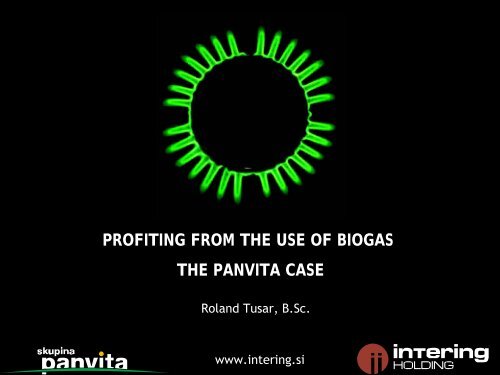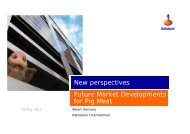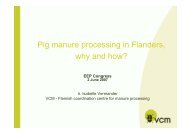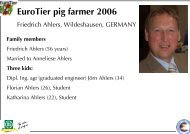profiting from the use of biogas the panvita case - European Pig ...
profiting from the use of biogas the panvita case - European Pig ...
profiting from the use of biogas the panvita case - European Pig ...
You also want an ePaper? Increase the reach of your titles
YUMPU automatically turns print PDFs into web optimized ePapers that Google loves.
PROFITING FROM THE USE OF BIOGAS<br />
THE PANVITA CASE<br />
Roland Tusar, B.Sc.<br />
www.intering.si
Biogas is a mixture <strong>of</strong> different gases like methane, carbon dioxide, hydrogen sulphide, nitrogen and o<strong>the</strong>r gases.<br />
Presence <strong>of</strong> all <strong>the</strong>se gases is a result <strong>of</strong> decomposition <strong>of</strong> <strong>the</strong> organic matter.<br />
BIOGAS PROPERTIES<br />
Aproksimative formula for anaerobic degradation by Buswell (simplified):<br />
CaHbOc ————> (a/2 + b/8 – c/4) CH4 + (a/2 – b/8 + c/4) CO2<br />
Basically <strong>the</strong> environmental aim <strong>of</strong> <strong>biogas</strong> production is reduction <strong>of</strong> greenho<strong>use</strong> emissions and substitution <strong>of</strong><br />
fossil energy.<br />
THEORETICAL METHAN YIELD<br />
BIOGAS DEFINITION
SHORT HISTORY OF BIOGAS<br />
- b.c. - Marco Polo mentions <strong>the</strong> <strong>use</strong> <strong>of</strong> covered sewage tanks in ancient Chinese<br />
literature,<br />
-in 1776 - Alessandro Volta concluded that <strong>the</strong>re was a direct correlation between<br />
<strong>the</strong> amount <strong>of</strong> decaying organic matter and <strong>the</strong> amount <strong>of</strong> flammable gas produced,<br />
-in <strong>the</strong> 1930s - <strong>the</strong> development <strong>of</strong> microbiology as a science led to research by<br />
Buswell and o<strong>the</strong>rs in <strong>the</strong> 1930s to identify anaerobic bacteria and <strong>the</strong> conditions that<br />
promote methane production,<br />
-in 1937 – municipal park cars <strong>of</strong> several German cities (e.g. Muenchen) ran on <strong>biogas</strong><br />
<strong>from</strong> sewage treatment,<br />
-in 1972 – due to <strong>the</strong> oil-crisis, construction <strong>of</strong> <strong>biogas</strong> plants became interesting<br />
again,<br />
- today (for instance); in Germany in 1992 <strong>the</strong>re were as few as 100 <strong>biogas</strong> plants,<br />
but in 2005 <strong>the</strong>ir number due to favored legislation has increased to 4.000 capable <strong>of</strong><br />
cumulative power production <strong>of</strong> nearly 1.000 MW
- savings for <strong>the</strong> farmers,<br />
WHY BIOGAS IS STILL POPULAR TODAY?<br />
- improved fertilization efficiency by replacing mineral fertilizer with organic fertilizer<br />
(digested slurry),<br />
- less greenho<strong>use</strong> gas emission,<br />
- cheap and environmentally sound waste recycling,<br />
- reduced nuisance <strong>from</strong> odors and flies,<br />
- pathogen reduction through sanitation, all this connected to renewable energy<br />
production,<br />
- less dependent on fuels and natural gas imports
ANAEROBIC DIGESTION (FERMENTATION)<br />
5 C 6 H 12 O 6 ————> 2 CH 3 CHOH ◦ COOH +<br />
4 CH 3 CH 2 COOH + 3 CH 3 COOH +CH 3 CH 2 OH+<br />
4 CO 2 + 2 H 2 + H 2 O<br />
5 glucose = 2 lactic acid + 4 propionic acid +<br />
3 acetic acid + ethanol + 4 carbon dioxide + 2<br />
hydrogen + water, or simplified:<br />
C 6 H 12 O 6 ————> 3 CH 3 COOH<br />
The methane production takes place by one<br />
<strong>of</strong> <strong>the</strong> two processes:<br />
3 CH 3 COOH ————> CH 4 + CO 2 and<br />
4 H 2 + CO 2 ————> CH 4 + 2 H 2 O
ANAEROBIC DIGESTION (FERMENTATION)<br />
Methanogenesis is a final step <strong>of</strong> <strong>the</strong> process resulting in production <strong>of</strong> CH4 and<br />
CO2, here MO such as acetotrophic and hydrogenotrophic take palce. These MO are<br />
very sesitive to T, pH, NH3 and H2S plus <strong>the</strong>y have very slow repruduction time (1<br />
to 10 days).<br />
Typs <strong>of</strong> anaerobic digestion processes with ref. to temperature<br />
Process <strong>of</strong> anaerobic digestion (fermetation)
KEY PROCESS VALUES<br />
H 2 CONCENTRATION<br />
change in free energy (kJ)
KEY PROCESS VALUES<br />
TEMPERATURE<br />
HRT (d)
KEY PROCESS VALUES<br />
pH
KEY PROCESS VALUES<br />
HYDRAULIC RETENTION TIME
KEY PROCESS VALUES<br />
VOLUME LOADING
KEY PROCESS VALUES<br />
OVERLOADING<br />
HRT: 16d, fresh manure – TSS: 10%, volume loading: 5,2 kgVSS/m3.d
PRESENT INTEREST IN ANAEROBIC DIGESTION<br />
- an increased recognition, in both developing and industrial countries, <strong>of</strong> <strong>the</strong> need for technical and economical<br />
efficiency in <strong>the</strong> allocation and exploitation <strong>of</strong> resources,<br />
- shifting <strong>from</strong> <strong>the</strong> main purpose <strong>of</strong> energy production, into a multi-functional system:<br />
a) treatment <strong>of</strong> organic wastes and wastewaters in a broad range <strong>of</strong> organic loads and substrate<br />
concentrations;<br />
b) energy production and utilization;<br />
c) improvement <strong>of</strong> sanitation; reduction <strong>of</strong> odors;<br />
d) production <strong>of</strong> high quality fertilizer<br />
- R & D has shifted <strong>from</strong> basic studies on anaerobic fermentation to <strong>the</strong> digestion <strong>of</strong> more complex materials<br />
that need modified digester designs. The main fields <strong>of</strong> R & D activities are:<br />
a) fermentation at high organic loadings;<br />
b) high rate digestion <strong>of</strong> diluted waste waters <strong>of</strong> agro-industries including substrate separation during<br />
fermentation; immobilization <strong>of</strong> <strong>the</strong> microorganisms;<br />
c) fermentation and re-<strong>use</strong> <strong>of</strong> specific materials in integrative farming systems;<br />
d) <strong>biogas</strong> purification;<br />
e) simple but effective digested design/construction <strong>of</strong> standardized fermenters;<br />
f) domestic waste water treatment.
SUBSTRATE FOR BIOGAS PRODUCTION
SUBSTRATE FOR BIOGAS PRODUCTION<br />
SANITATION
BIOGAS QUALITY<br />
S2- ————> HS- ————> H2S
BIOGAS QUALITY<br />
H2S + H2O ————> H3O + + HS -<br />
Methods for H2S elimination:<br />
- biochemical oxidation by dosing 3-5% <strong>of</strong> air inside or outside digester<br />
- chemical elimination by dosing salts (Fe++) into gas stream<br />
Common <strong>use</strong> <strong>of</strong> <strong>biogas</strong> in Europe:<br />
- in CHP (combined heat and power units e.i. co-generators)<br />
For <strong>the</strong> CHP <strong>the</strong> <strong>biogas</strong> quality concerning H2S is required to be less <strong>the</strong>n 600 ppm.
DIGESTED SLURRY (EFFLUENT) MANAGEMENT / TREATMENT<br />
Effects <strong>of</strong> digestion on slurry properties:<br />
− reduction <strong>of</strong> COD up to 85%,<br />
− nitrogenous compounds are mostly in form <strong>of</strong> NH 4 + while<br />
total nitrogen stays unchanged,<br />
− volatile organic compounds are reduced (elimination <strong>of</strong> odour<br />
causing components),<br />
− no changes to P<br />
− increase in pH<br />
The fermentation process results in:<br />
− less organic loading for aquatics<br />
− improved N - availability<br />
− possibility <strong>of</strong> NH3 loss
DIGESTED SLURRY (EFFLUENT) MANAGEMENT / TREATMENT<br />
Two kinds <strong>of</strong> slurry disposal are possible:<br />
- direct <strong>use</strong> on fields <strong>of</strong> non separated slurry using different techniques as splashing,<br />
trailing or injection,<br />
- separation <strong>of</strong> solid and liquid part <strong>of</strong> <strong>the</strong> slurry using filtering techniques<br />
(separators, centrifuges, filter belt presses etc)<br />
o scattering <strong>of</strong> <strong>the</strong> solid part on <strong>the</strong> fields<br />
o fur<strong>the</strong>r treatment <strong>of</strong> <strong>the</strong> liquid part befor discharging into water recipient<br />
Possible methods (BAT) for fur<strong>the</strong>r treatment <strong>of</strong> liquid part <strong>of</strong> <strong>the</strong> slurry:<br />
- stripping <strong>of</strong> ammonia<br />
-ion –exchangeprocesses<br />
- membrane filtration / reverse osmosis<br />
- biological treatment (aerobic)<br />
- chemical treatment (adsorption/absorption)<br />
After separation approximately 80% <strong>of</strong> phosphorus and 20% <strong>of</strong> nitrogen is kept in solid<br />
part <strong>of</strong> <strong>the</strong> slurry <strong>use</strong>able as a fertilizer.
PROFITABILITY OF BIOGAS PRODUCTION<br />
Basically <strong>the</strong>re are six folds <strong>of</strong> consideration:<br />
- cost <strong>of</strong> substrate (seeding, harvesting, transport, ensilaging)<br />
- specific operational cost <strong>of</strong> <strong>biogas</strong> technology<br />
- revenue <strong>from</strong> substrate - if applicable (i.e. tipping fee)<br />
- revenue <strong>from</strong> electricity (at fixed unit price per kWh <strong>of</strong> generated electrical power)<br />
- revenue <strong>from</strong> nutrients<br />
- revenue <strong>from</strong> heating supply to external consumers – not very <strong>of</strong>ten
PROFITABILITY OF BIOGAS PRODUCTION<br />
capital costs<br />
operational costs
PROFITABILITY OF BIOGAS PRODUCTION
PROJECT ID<br />
Project builder: Intering Holding, Roland Tušar, B.Sc.<br />
Project operator: KG Rakican - Ekoteh<br />
Substrate supplier: Panvita group <strong>of</strong> companies<br />
Digested slurry up-taker: Panvita group <strong>of</strong> companies<br />
THE PANVITA CASE
THE PANVITA CASE
THE PANVITA CASE






